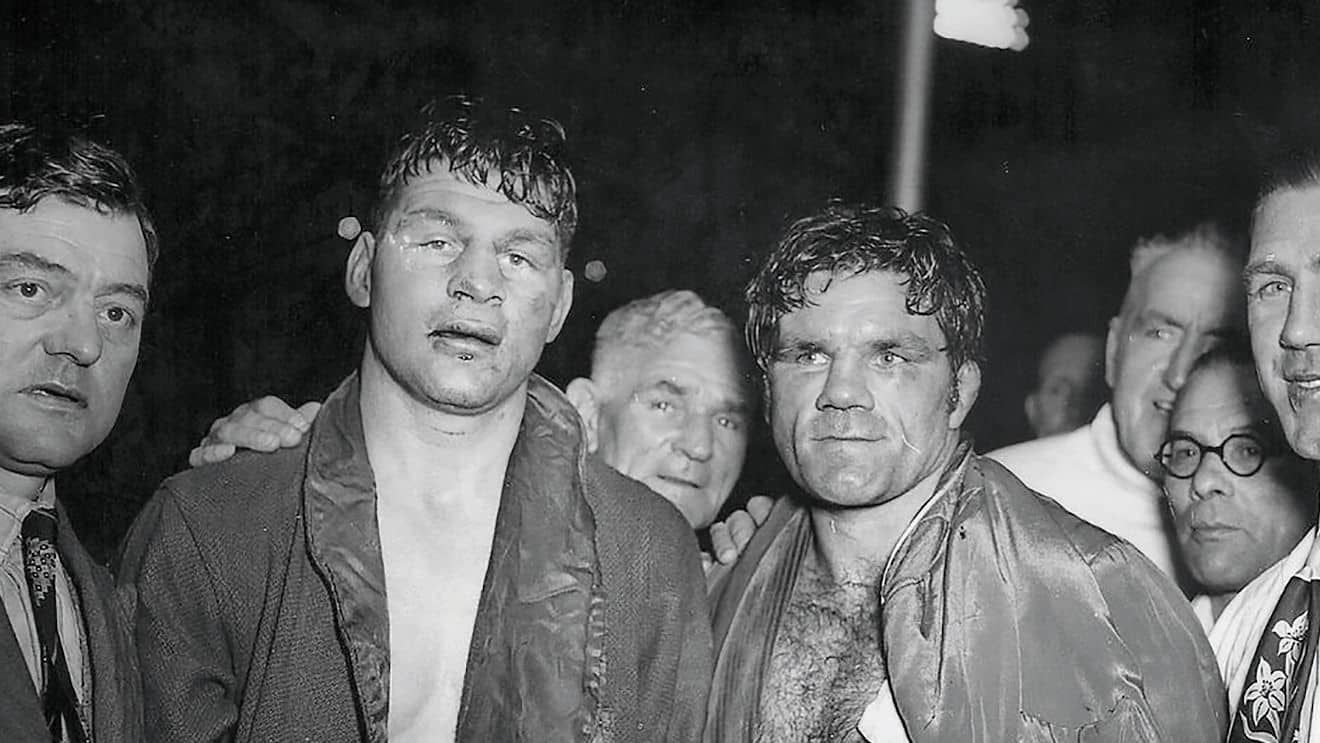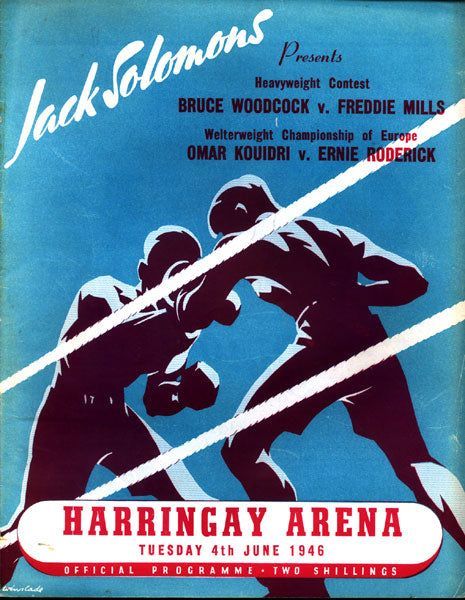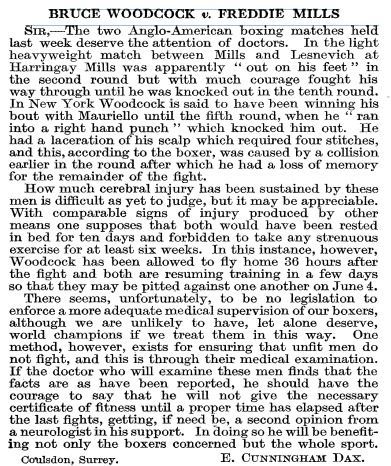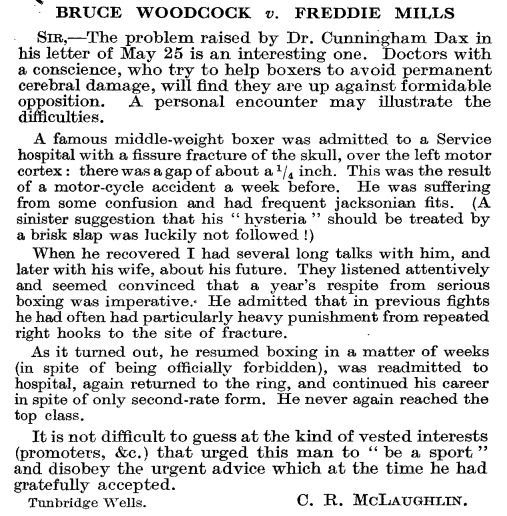4th June - Woodcock vs Freddie Mills (London) - Background
Bruce’s comeback from the shock of the Mauriello defeat was a significant national duel, against the other main contender for a shot at Joe Louis, Freddie Mills. In his day Mills was a very popular and admired slugger, but his later career and death in suspicious circumstances cast a shadow over his reputation which has been further deepened by other speculation about him
Bruce’s training for the Mills fight included sparring with Barnsley welterweight George Dilks and Filey heavy-weight Joe Barrett. He was also helped with training by his bother Malcolm who had recently won his first professional fight under the name Billy Carroll with a knock-out.
Bruce was seen off by brothers Billy and Malcolm from Doncaster station bound for Kings Cross. Bruce put up at a West-End hotel for the night with brother Billy. Sam and Malcolm were due down the next day.
The fight in Harringay, promoted by Jack Solomons, was a sell-out with not a ticket left. Despite being billed as a non-title bout, the fight was of crucial significance for the future of British boxing and for the careers of both men. Whoever won would be in direct line for a crack at the world title against Joe Louis. Bruce and Mills were the only two British hopes for that status and this deciding confrontation would establish the line of succession in British heavy-weight boxing for some time to come. In a neat reversal of his meeting with Mauriello, this time Bruce had the advantage of weight but also of experience, not least that gained during his time in America. Mills had been out of the ring for 15 months after being posted by the RAF to India. After being demobilised in March 1946, Mills had put up a gallant performance against American Gus Lesnevich in May for Lesnevich’s world light heavyweight title in Harringay. Despite recovering from a second round flooring and continuing battling until the tenth, Mills was finally knocked down twice before the referee stopped the fight in Lesnevich’s favour. The contest against Bruce was three weeks later.
The Fight
With so much at stake, the fight was expected to be a hectic affair and that’s what it proved. Opening to a fanfare of trumpets, the 11,000 strong crowd witnessed a thrilling fight which went the full 12 hard-fought rounds.
Both men gave and took as much as they could, with Mills suffering a cut on the forehead as well as a gash under his eye, while Bruce had a split over his left eye, damage to his lip and a bleeding nose. Neither needed stitches. But for all their equality in courage and toughness, the victory was clearly Bruce’s. The existing 16 minutes of footage of the highlights gives an idea of the ferocity of the confrontation and the excitement surrounding it, with a slow-motion camera giving an insight into the power of the punches on both sides. The video image is currently unavailable but we are actively working to bring this back to the website.
1946 Account of the Fight
The following is a ringside account of the time from Gerard Walter in the London
Daily News of 5th June:
‘Bruce Woodcock beat Freddie Mills on points over 12 rounds at Harringay arena last night in the most punishing fight seen in an English ring for many years. At the end the left eye of each man was closed, and in addition Woodcock's mouth was bleeding profusely. It was not an exhibition of scientific boxing; we did not expect that. But the fight did prove again the tremendous gameness of Mills.
Giving away nearly a stone in weight he stood up to the British heavyweight champion's terrific right-hand punching with a courage that rightly earned him an ovation from the 14,000 present. Mills is the only Englishman to go the distance with Woodcock since Charlie Bundy was beaten on points over six rounds by the Doncaster man in 1942.
By sheer grit Mills remained on his feet to the end. That, and Woodcock's comparative inexperience, saved the loser on two occasions from a knockout. In the eighth round Woodcock smashed that vaunted right of his on to Mills's jaw. Mills was hurt and momentarily helpless. To my surprise Woodcock. instead of following up his advantage, stood back - and the the chance was lost. Again in the 10th round he committed precisely the same mistake. He had his opponent practically helpless against the ropes with three heavy rights in succession. The crowd roared in anticipation of the ‘kill.’ Woodcock had only to land one full-blooded punch and Mills must have gone down. Woodcock stood still and poked out a feeble, tentative left, which Mills slipped easily and hung on for the precious strength-regaining seconds.
I give Mills full credit for a very gallant performance, however. He never gave up. No matter what punishment his obviously defective defence invited, he was always ready to mix it. Woodcock. I think, realised early that his opponent did not possess the power to put him down. The Doncaster boxer was very cool and confident throughout the fight. Even when his eye was closed in the 11th round he was completely master of himself. But for once he met a man who could take the best he had to give. But, then, none of us has ever doubted Mills's pluck.’
As Walter suggests, Mills had given Bruce valuable experience of a hard-won extended match which he had to battle over many rounds to win. By comparison with many of his short victories in the past, he had to display resilience, endurance and grit as well as superior skill and power to beat Mills. It would stand him in good stead for the rest of the year and beyond. And it gave him a clear path once again to aim for the top - Joe Louis.

Mills vs Baksi 1946:
Mills went on to fight Joe Baksi in November this year, being heavily beaten after six rounds. Baksi was to be Bruce's nemesis in 1947, as we'll see.
Programmes

Letters to the Lancet


